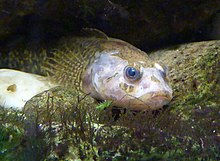Bullhead Carnival
The Gropp Fasnacht in Ermatingen on Lake Constance ( Canton Thurgau ) is the most traditional carnival in eastern Switzerland . It is also known as the “latest carnival in the world”, because it only takes place three weeks before Easter on Sunday Laetare , when it has long been Lent elsewhere . The highlight of the “bullhead parade” only takes place every three years; the last date was March 11, 2018.
origin
During the Council of Constance (1414-1418), according to a legend, one of the three anti-popes , John XXIII. , secretly fled Constance and came to Ermatingen. According to tradition, the Pope is said to have allowed the Ermatingern to celebrate Carnival again at this time as thanks for the food. The people of Ermating therefore attribute the Groppen Carnival to this papal visit. According to the legend, the name Groppenfasnacht comes from the species of fish called bullhead , which Johannes XXIII. was served as dinner in the rectory (fish is a fasting dish ). The bullhead is a small predatory fish that was often caught and fried as a delicacy in earlier times, but has become rare today.
The Groppenfasnacht probably has its origins in a spring festival of fishermen on the Untersee of Lake Constance , which dates back to old Germanic times . The beginning of the annual bullhead fishing season after the thawing of the shallow Untersee was probably the reason to celebrate a spring festival, and thus - comparable to other customs in the region, e.g. B. the Sechseläuten in Zurich - "to drive out the winter". As the bullheads were only caught with trawls in spring, a large amount of bullheads was available at one stroke with the first fishing trip, which were kept alive until the big festival (dinner), which was then always necessary for practical reasons.
The Pope legend probably served to give the actually pagan custom a Christian reason, but the dates of the events around the council also roughly coincide with the date of the Groppenfastnacht. The first written mentions about the "bullhead parades" that were held date from the end of the 19th century.
procedure
For many centuries, Groppenfasnacht was only celebrated in the "Staad", the original fishing settlement on the Swiss shores of Lake Constance . In the higher-lying «Oberdorf», however, the usual "Bauern" - or " Alte Fastnacht " was held. It is unclear when the two festivals were merged.
The three-day carnival is celebrated every year. Only every three years (z. B. 2021) takes place on Sunday Laetare the "Gropp removal» held a combined fishing, Spring Alemannic carnival procession . About 40 groups and 1,500 individuals are involved in it. The move is organized by a committee of 58 people. Around ten thousand visitors from all over the Lake Constance area, including from the German border area, follow him.
The parade is led by "König Gropp" (an oversized bullhead), followed by the fishermen who show their catch. “Reed monsters”, frogs and similar figures also belong to this environment.
In the parade there is a colorful mix of traditional fishermen's groups as well as carnival floats with satirical allusions and flower floats, groups with colorful presentations of spring and fairy tale themes ("subjects"), as well as numerous guggen music groups.
The program of the multi-day Groppen Carnival is complemented by, among other things, a village carnival evening in the hall with a large stage program, gugges and dance, as well as the pub carnival in the local inns, where Guggenmusics are also played and “ Schnitzel banks ” are performed.
Web links
Individual evidence
- ↑ Groppen Carnival in Ermatingen on Lake Constance
- ↑ groppenfasnacht.ch
- ↑ Here greets Imperia. In: Südkurier of March 16, 2015.
- ↑ Obergropp with body and soul. In: Outlook, November 2017, pp. 6–7.


